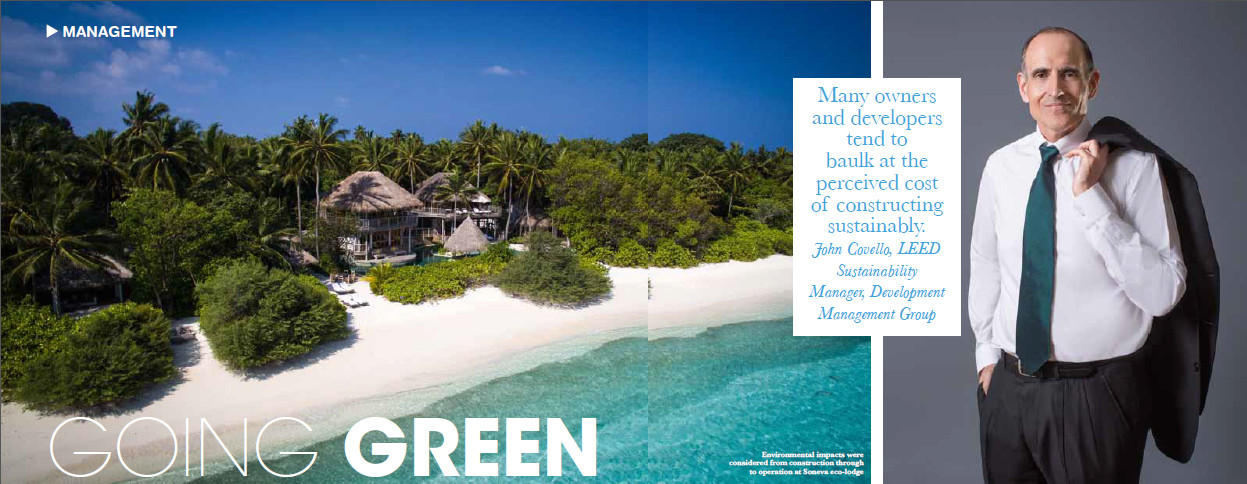
‘Going Green’ is still a top issue for hotels and guests and it is not
without its challenges. But despite associated costs, the industry is
committed to sustainability, looking at its longer term, cost- and
resource-saving benefits. Donald Gasper investigates
Rising concerns over the deteriorating condition of the environment has led to the implementation of green methods in most Asian countries. the growth of green technology, especially in the construction sector, is considered vital for improving the condition of the environment. By adopting eco-friendly construction methodologies, real estate developers can help reduce energy and water consumption in hotels.
With most hotels looking for new ways of assuming their social responsibilities, the adoption rate of green technology in the hospitality industry has risen in the Asia-Pacific region. By judicious use of non-renewable resources, green hotels help in reducing the rate of waste production, pollution and environmental degradation. Green hotels emphasise factors like reducing, recycling and reusing solid waste; lowering the usage of harmful chemicals; saving energy and water, and improving the quality of air inside the hotel.
GREEN HOTELS MEAN MORE GREENBACKS
The high costs of implementation of eco-friendly measures can sometimes be seen as a disincentive for green hotels. However, it must be noted that the high energy, water and electricity consumption rates of conventional infrastructure account for the bulk of natural resource consumption across the world. Moreover, hotel owners realise that energy efficient buildings will be rented or sold at higher rates than conventional infrastructure. therefore, it can be argued in justification that implementing measures to make buildings eco-friendly can help reduce the burden on the environment in the long run, while benefiting the owner too.
Sustainably designed hotels seem at first to be a challenge to investors and owners, but the long-term payback on these investments is well worth it. A hotel designed sustainably will usually offer financial dividends for the hotel in a few
years, will serve as an example of the owner’s commitment to saving the environment, and also contribute to the welfare of its staff and guests, as green hotels have a healthier internal environment.
John Covello, LEED sustainability manager at Development Management Group (DMG), says that many owners and developers tend to baulk at the perceived cost of constructing sustainably. DMG is a Construction and Development Manager headquartered in Phuket, ftailand, serving owners, developers, real estate investors and buyers in luxury resort and residential developments. It advises clients in ftailand, Cambodia, Myanmar and Singapore.
Accreditation in LEED, which stands for Leadership in Energy and Environmental Design – acknowledges technical competence in green building practices and principles.
“We are seeing more and more owners and building operators in Southeast Asia interested in sustainability simply because of the sound financial return provided by the savings in operating expense that come from a sustainable and green building,” says Covello’s colleague, David Arell.
The perceived extra costs are thought to be as high as 20 per cent extra above normal costs, Covello says, hence seeming prohibitive. Sustainable buildings, however, can usually be designed for less than 5 per cent above normal costs.
SUSTAINABLE DESIGN
A World Business Council for Sustainable Development study analysed 146 certified green buildings and found an actual average marginal cost of less than 2 per cent. Many sustainable measures are inexpensive. LED lighting for example is now priced competitively with more traditional incandescent and fluorescent lights, and lasts five to 10 times longer.
Many construction materials such as aerated concrete blocks and UPVC window panels are not costly and can contribute to energy savings. Measures like these will lower operating costs over time. One Green Economy Post article cites LEED buildings as using 30 to 50 per cent less water and energy than those built under current codes.
Having a guidelines to sustainable design can be a great benefit for building a green hotel. there are many qualified architects and engineering firms that can lead the process for sustainable design.Owners can also choose a green certification system such as LEED, BREEAM, Green Mark or EDGE to provide a framework for sustainable design.
These systems have the added benefit of the marketing value that shows the property has been certified by a respected independent third party. Many qualified consultants are available to help lead owners/developers through the certification process.
Going green results in more revenue for hotel operators. A Cornell University study showed hotel ADR to be on average US$20 higher for LEED-certified hotels versus non-certified hotels.
Designing a green hotel or resort will have some upfront financial challenges but the long-term reduced operating costs and potential increased revenue make for a good return on these investments



